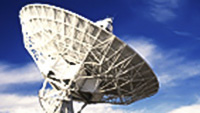Search and order online
In Earth’s shadow: Sound of BepiColombo Earth flyby
- Video Online only
- Title In Earth’s shadow: Sound of BepiColombo Earth flyby
- Released: 06/05/2020
- Length 00:00:21
- Language English
- Footage Type Documentary
- Copyright ESA/BepiColombo/ISA/ASI-INAF, CC BY-SA 3.0 IGO
- Description
A sonification of data recorded by the Italian Spring Accelerometer (ISA) aboard the BepiColombo spacecraft as it flew through Earth’s shadow during the April 2020 flyby.
The data show the moment when BepiColombo entered the 34-minute eclipse period when its solar panels were not exposed to direct sunlight, proving that the instrument is capable of detecting the smallest differences in motion.
“The Sun produces a little bit of force that acts on the spacecraft’s surface and also on the solar panel surface,” explains Carmelo Magnafico, a researcher at Italy’s National Institute for Astrophysics (INAF), which developed the instrument. “When the spacecraft goes into the shadow, the effect disappears, and you can see a jump in acceleration in our plot and hear a change in the volume and characteristics of the related sound.”
The spacecraft had already passed its closest approach when it entered the shadow. The recording starts at the distance of 13 460 km away from the Earth’s surface. The spacecraft subsequently enters eclipse while at the distance of 16 496 km and exits it at 24 861 km. The recording ends when the spacecraft reaches the distance of 31 785 km.
The original frequency of the dataset, inaudible to humans, had to be enhanced by the team in order to create the audio track. Measurements from the approximately half-hour eclipse were condensed into less than a half-minute recording.
Carmelo compares the recording to the sound conducted through the rail when a train is approaching. The accelerometer registers vibrations of the spacecraft caused by both, external and internal factors. Being able to clearly pick up such a subtle external influence proved that the instrument is ready for real science.
“This is an extraordinary situation, because since we started the cruise, we have only been in direct sunshine, so we did not have the possibility to check effectively whether our instrument is measuring the variations of the force of the sunlight,” Carmelo says. “This is a proof for us that the instrument is well-calibrated because the jump in the acceleration we measured is in line with our expectations.”
Once at Mercury, the ISA instrument will focus on studying the gravitational field of the smallest planet of the Solar System and its variations due to solar tides. Mapping local gravity anomalies will help scientists to better understand the internal structure of Mercury, a perplexing planet with a larger than expected inner core and an unexpected magnetic field.
The video accompanying the audio sequence consists of images captured by three ‘selfie’ cameras aboard BepiColombo’s transfer module. The images correspond with the time when the audio recording was obtained.


